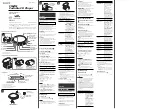
1
9. USE PROTECTIVE EQUIPMENT.
Use
safety glasses. Use face or dust mask if
cutting operations create dust.
10. CONNECT DUST EXTRACTION
EQUIPMENT.
If devices are provided
for the connection of dust extraction and
collecting equipment, ensure these are
connected and properly used.
11. DO NOT ABUSE THE CABLE.
Never
pull the cable to disconnect it from the
socket. Keep the cord away from heat,
oil and sharp edges.
12. SECURE WORK.
For safety reasons,
wherever possible use clamps or a vice
to hold the work piece securely. It is
safer than using your hands.
13. DON’T OVERREACH.
Keep proper
footing and balance at all time.
14. MAINTAIN TOOLS WITH CARE.
Keep cutting tools sharp and clean for
better and safer performance. Follow
instructions for lubricating and changing
accessories. Inspect tool cords
periodically and if damaged have them
repaired by an authorised service facility.
Inspect extension cords periodically and
replace if damaged. Keep handles dry,
clean and free from oil and grease.
15. DISCONNECT THE POWER SOURCE.
When not in use you should disconnect
tools from their power source, especially
when changing blades, bits, cutters
or other similar accessories and for
servicing.
16. REMOVE ADJUSTING KEYS AND
WRENCHES.
Form the habit of
checking to see that keys and adjusting
wrenches are removed from the tool
before turning it on.
17. AVOID UNINTENTIONAL STARTING.
Ensure switch is in “off” position when
plugging in.
18. USE OUTDOOR EXTENSION LEADS.
When the tool is used outdoors, use only
extension leads intended for outdoor
use and so marked.
19. STAY ALERT.
Watch what you are
doing, use common sense and do not
operate the tool when you are tired.
General Safety Rules
Read all these instructions before
attempting to operate your product.
Save these instructions for future
reference.
1. KEEP WORK AREA CLEAR.
Cluttered
work areas and benches invite injuries.
Keep the floor area around you level,
well maintained and free from loose
materials, such as chips and excess
stock.
2. CONSIDER WORK AREA
ENVIRONMENT.
Do not expose tools
to rain. Do not use tools in damp or wet
locations. Keep work area well lit. Do not
use tools in the presence of flammable
liquids or gases.
3. GUARD AGAINST ELECTRIC SHOCK.
Avoid body contact with earthed or
grounded surfaces.
4. KEEP OTHER PEOPLE AWAY.
Do
not let others, especially children, not
involved in the work touch the tool or
the extension lead and keep them away
from the work area.
5. STORE IDLE TOOLS.
When not in use,
tools should be stored in a secure and
dry location that it is safely out of reach
from children.
6. DO NOT FORCE THE TOOL.
It will do
the job better and safer at the rate for
which it was intended.
7. USE THE RIGHT TOOL.
Do not force
small tools to do the job of a heavy
duty tool. Do not use tools for purposes
not intended; for example do not use
circular saws to cut tree limbs or logs.
8. DRESS PROPERLY.
Do not wear loose
clothing or jewellery, they can be caught
in moving parts. Non-skid footwear is
recommended when working outdoors.
Wear protective hair covering to contain
long hair.
WARNING ! When using electric tools
basic safety precautions should always
be followed to reduce the risk of fire,
electric shock and personal injury.
Summary of Contents for AP3300
Page 1: ...1 GB 13 IN 330 MM BENCH THICKNESSER AP3300 INSTRUCTION MANUAL...
Page 2: ...2 CONTENTS GB P 1 8 The original instruction manual is in English...
Page 14: ...11 Fig 16 Fig 18 Fig 17 Fig 14 4 3 4 6 5 8 7 Fig 15 1 2 1 2...
Page 16: ...13 MODEL AP3300 Schematic A...
Page 18: ...15 Schematic B MODEL AP3300 MANUAL INSTRUCTION...
Page 20: ...17...





































